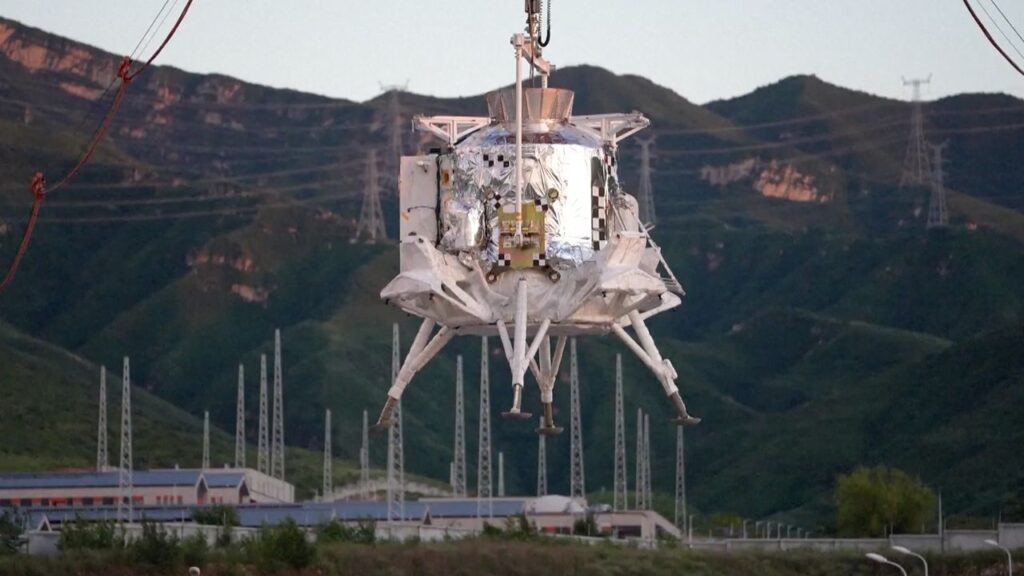
China is making significant strides toward its ambitious goal of landing astronauts on the moon by 2030. The nation recently conducted a critical ground test of the first-stage propulsion system for its Long March 10 (CZ-10) rocket, which is being developed specifically for lunar missions. This test took place on August 15, 2025, at the Wenchang Satellite Launch Center in Hainan Province, showcasing the capabilities essential for future crewed spaceflights.
During the test, engineers fired up a shortened mockup of the CZ-10’s first stage, equipped with seven YF-100K engines fueled by liquid oxygen and kerosene. The engines produced a remarkable thrust of nearly 1,000 tons, setting a new record for China’s space program. The test lasted approximately 35 seconds, demonstrating the rocket’s power and stability.
Xu Hongping, an engineer with the China Aerospace Science and Technology Corporation (CASC), explained the design of the rocket. He described the first stage and boosters as a “universal core stage,” consisting of three identical core modules bundled together. This innovative design aims to enhance the rocket’s functionality and efficiency for lunar missions.
The significance of this propulsion test cannot be overstated. According to Peng Yue, another engineer at CASC, the test is critical for assessing the thermal and mechanical conditions produced by operating all seven engines simultaneously. This step is vital for ensuring system compatibility and reducing risks ahead of the rocket’s inaugural flight.
Progress in Lunar Exploration
The recent static fire test is part of a broader series of milestones achieved by China in its quest to send humans to the moon. Earlier this year, on June 17, a successful pad-abort test of the Mengzhou crewed spacecraft demonstrated China’s commitment to safety and innovation. During this test, the Mengzhou’s escape engine propelled the capsule-tower assembly upward, separating the return capsule from the escape tower at a predetermined altitude. This was the first zero-altitude escape test for a manned spacecraft in the country in 27 years.
On August 6, China conducted a simulated takeoff and landing of its Lanyue lunar lander at a specialized test site in Zhangjiakou, Hebei Province. This site previously tested the Tianwen-1 Mars lander, which successfully deployed the Zhurong rover on the Red Planet in 2021. The Lanyue lander is designed to transport two astronauts between lunar orbit and the moon’s surface. It is also capable of carrying a lunar rover and scientific equipment to facilitate extended astronaut missions.
The August test validated various systems within the lander, including lunar touchdown protocols and control plans. It also assessed the compatibility of subsystems related to guidance, navigation, control, and propulsion.
According to the China Manned Space Agency (CMSA), the Lanyue lander will serve as the “lunar life center, energy center, and data center” for astronauts upon their arrival on the moon. This facility will support their activities and residence during lunar missions.
Advancements in Space Suit Technology
As part of its preparations for lunar exploration, China has also unveiled a new lunar spacesuit, which was introduced by CMSA in September. The suit is designed with protective materials to shield astronauts from the harsh lunar environment and pervasive dust. It features a multifunctional integrated control panel and cameras for various recording tasks.
The spacesuit includes flexible gloves, a panoramic glare-proof helmet visor, and joints specifically adapted for low-gravity conditions. Its lightweight design facilitates a range of activities on the lunar surface, from descending to the ground to performing tasks such as walking and kneeling.
China’s ambitious plans for lunar exploration demonstrate not only its technological advancements but also its determination to establish a significant presence in space exploration by the end of the decade. As these developments unfold, the world watches closely to see how this space race will evolve in the coming years.







